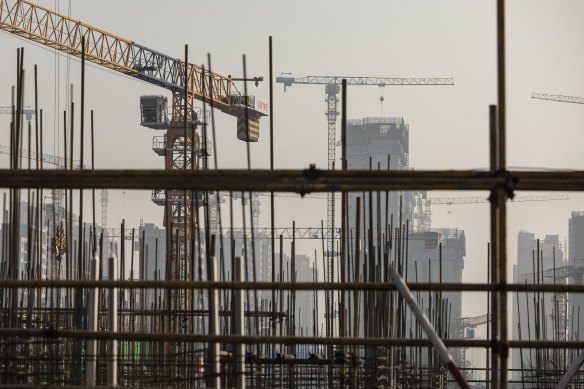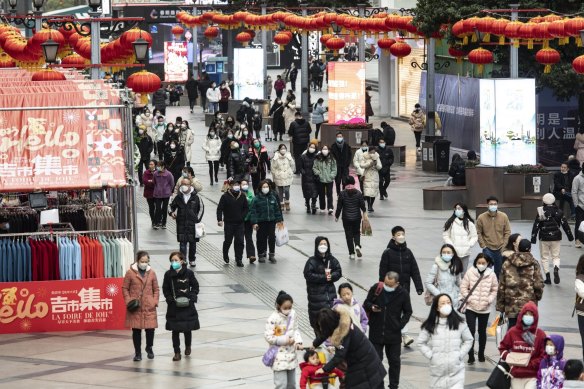
Friday’s announcements, may, however, be a preview of something large to come. The central committee of the Communist Party will hold a plenum, or assembly, in July, which will outline China’s economic strategy for the next five years. It is conceivable that there could be more to come on the property front.
On Friday, China sold the first tranche of a special trillion-yuan, 30-year bond issue.

China has a massive number of uncompleted and unsold properties that have further weighed on the market.Credit: Bloomberg
It’s unusual for China to issue such long-dated bonds, and it hasn’t yet revealed how those funds will be deployed, but on Friday, China’s central bank, the People’s Bank of China, announced that – separate from the 300 billion yuan of funding for housing purchases – it would make 500 billion yuan available to support urban redevelopment.
Suddenly, three years into the implosion of its property sector – a sector that used to account for more than 25 per cent of its GDP and which holds about 70 per cent of Chinese households’ assets – the government is doing something meaningful and investing/lending meaningful funds to try to respond to the massive over-capacity in its housing stock.
The need for a more substantive response was underscored by economic data that was also released on Friday.
Property sales by floor area in the four months to the end of April were down more than 20 per cent from the same period of last year. Property investment was 9.8 per cent lower. New construction starts were almost 25 per cent lower.
If it wants to reduce the risk of a broader economic crisis and the 30-year growth trap that Japan fell into in the 1990s, China needs to rebuild the confidence and willingness to spend of its massive base of domestic consumers.
Sliding sales, falling prices, collapsing developers and shrinking investment have been the industry experience for most of the past three years, despite endless small measures designed to stimulate demand – mainly reduced interest rates, smaller deposits, more relaxed restrictions on mortgages and some local government incentives for property purchases.
It doesn’t appear from the state media’s reporting of Friday’s announcements that there will be any restriction on the properties – any distinction between properties owned by state-owned or private developers – that the state-owned enterprises earmarked as buyers will be able to acquire.
That could provide, if not a lifeline, then at least some welcome liquidity for the mainly (but not entirely) private sector developers who have been reliant on a pre-sales model to generate the cash for their developments. That model collapsed as housing prices tumbled, sales dried up, and the stock of unsold properties swelled.
At face value, Friday’s measures look like a state bailout of private sector companies.

China desperately needs to boost consumer confidence in the economy. Credit: Bloomberg
While it’s the option of last resort for a government to effectively act as the buyer of last resort, it isn’t unprecedented.
In the US, something similar happened on a vastly larger scale after the 2008 financial crisis, when the Bush administration enacted the Troubled Assets Relief Program in response to the subprime mortgage crisis to enable the government to buy mortgages and other toxic assets from US banks.
The US spent hundreds of billions to prop up its banks and property market – and ended the program having made a modest profit when the program was eventually wound up.
It had become increasingly obvious as China’s property sector continued to deteriorate and as the undermining of Chinese households’ largest stores of wealth continued and depressed demand that the government would have to intervene more assertively and expensively.
China needs to boost domestic consumption if it is to achieve its GDP growth target for this year, and probably beyond, of about 5 per cent. It’s not going to be allowed to export its way out of its challenges.
Its attempt to offset weak domestic demand with increased investment in manufacturing exports has led to excess factory capacity and declining export prices, and is running into a spreading backlash within its export markets, where it is being accused of dumping its surplus production.
Joe Biden’s new tariffs on China’s electric vehicles and other green technologies and similar restrictions on Chinese imports looming within Europe and elsewhere are only a foretaste of what’s to come if Donald Trump regains the presidency and slaps a 60 per cent tariff on all Chinese imports.
Loading
If it wants to reduce the risk of a broader economic crisis and the 30-year growth trap that Japan fell into in the 1990s, China needs to rebuild the confidence and willingness to spend of its massive base of domestic consumers.
That has to start with stabilising the property market. Friday’s announcements could be that start, but there will need to be more to come.
Read more:
Stephen Bartholomeusz: The US is tightening the screws on China



























